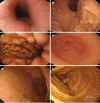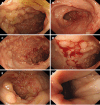Link between mutations in ACVRL1 and PLA2G4A genes and chronic intestinal ulcers: A case report and review of literature
- PMID: 38577076
- PMCID: PMC10989323
- DOI: 10.4240/wjgs.v16.i3.932
Link between mutations in ACVRL1 and PLA2G4A genes and chronic intestinal ulcers: A case report and review of literature
Abstract
Background: Genetic factors of chronic intestinal ulcers are increasingly garnering attention. We present a case of chronic intestinal ulcers and bleeding associated with mutations of the activin A receptor type II-like 1 (ACVRL1) and phospholipase A2 group IVA (PLA2G4A) genes and review the available relevant literature.
Case summary: A 20-year-old man was admitted to our center with a 6-year history of recurrent abdominal pain, diarrhea, and dark stools. At the onset 6 years ago, the patient had received treatment at a local hospital for abdominal pain persisting for 7 d, under the diagnosis of diffuse peritonitis, acute gangrenous appendicitis with perforation, adhesive intestinal obstruction, and pelvic abscess. The surgical treatment included exploratory laparotomy, appendectomy, intestinal adhesiolysis, and pelvic abscess removal. The patient's condition improved and he was discharged. However, the recurrent episodes of abdominal pain and passage of black stools started again one year after discharge. On the basis of these features and results of subsequent colonoscopy, the clinical diagnosis was established as inflammatory bowel disease (IBD). Accordingly, aminosalicylic acid, immunotherapy, and related symptomatic treatment were administered, but the symptoms of the patient did not improve significantly. Further investigations revealed mutations in the ACVRL1 and PLA2G4A genes. ACVRL1 and PLA2G4A are involved in angiogenesis and coagulation, respectively. This suggests that the chronic intestinal ulcers and bleeding in this case may be linked to mutations in the ACVRL1 and PLA2G4A genes. Oral Kangfuxin liquid was administered to promote healing of the intestinal mucosa and effectively manage clinical symptoms.
Conclusion: Mutations in the ACVRL1 and PLA2G4A genes may be one of the causes of chronic intestinal ulcers and bleeding in IBD. Orally administered Kangfuxin liquid may have therapeutic potential.
Keywords: Activin A receptor type II-like 1; Case report; Crohn’s disease; Intestinal ulcers; Phospholipase A2 group 4A; Ulcerative colitis.
©The Author(s) 2024. Published by Baishideng Publishing Group Inc. All rights reserved.
Conflict of interest statement
Conflict-of-interest statement: The authors declare that they have no conflict of interest.
Figures




Similar articles
-
Generalized Pyoderma Gangrenosum Associated with Ulcerative Colitis: Successful Treatment with Infliximab and Azathioprine.Acta Dermatovenerol Croat. 2016 Apr;24(1):83-5. Acta Dermatovenerol Croat. 2016. PMID: 27149138
-
Crohn's disease in a developing African mission hospital: a case report.J Med Case Rep. 2019 Mar 7;13(1):80. doi: 10.1186/s13256-019-1971-5. J Med Case Rep. 2019. PMID: 30846003 Free PMC article.
-
Intestinal Behçet's and suspected intestinal Behçet's disease: a report of four surgical cases.Surg Case Rep. 2024 Jan 2;10(1):3. doi: 10.1186/s40792-023-01798-2. Surg Case Rep. 2024. PMID: 38165549 Free PMC article.
-
A comprehensive review and update on Crohn's disease.Dis Mon. 2018 Feb;64(2):20-57. doi: 10.1016/j.disamonth.2017.07.001. Epub 2017 Aug 18. Dis Mon. 2018. PMID: 28826742 Review.
-
[X-linked inhibitor of apoptosis deficiency manifested as Crohn's disease: a case report and literature review].Zhonghua Er Ke Za Zhi. 2018 Jan 2;56(1):43-47. doi: 10.3760/cma.j.issn.0578-1310.2018.01.011. Zhonghua Er Ke Za Zhi. 2018. PMID: 29342997 Review. Chinese.
References
-
- Ng SC, Shi HY, Hamidi N, Underwood FE, Tang W, Benchimol EI, Panaccione R, Ghosh S, Wu JCY, Chan FKL, Sung JJY, Kaplan GG. Worldwide incidence and prevalence of inflammatory bowel disease in the 21st century: a systematic review of population-based studies. Lancet. 2017;390:2769–2778. - PubMed
Publication types
LinkOut - more resources
Full Text Sources

